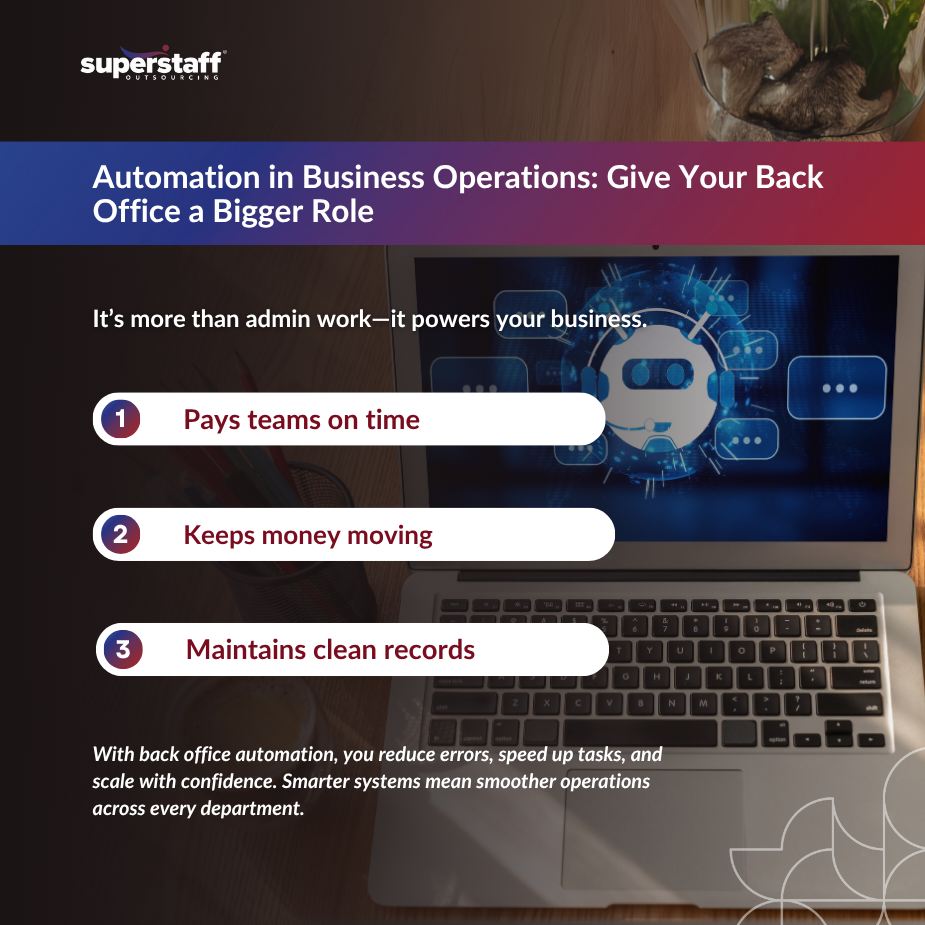
Cutting costs is often why companies choose to outsource back-office functions. But relying on manual processes can just move the problem instead of fixing it. If the work is slow, error-prone, or inconsistent, handing it to another team without improving the process only creates new issues.
Back-office tasks like payroll, reporting, data entry, and invoicing demand both speed and accuracy. These functions may not be customer-facing, but they have a direct effect on daily operations. Without effective systems, mistakes and delays can slow down your entire business, impact cash flow, and cause stress across departments.
That’s where automation in business operations makes a real difference. Automating routine tasks makes the process faster, more accurate, and easier to scale. Combining outsourcing with smart tools helps companies deliver better results, reduce errors, and boost team efficiency.
Here’s a closer look at why automation in business operations is becoming the smart choice for back-office outsourcing—and how you can make it work for you.
What the Back Office Really Does

The back office is not just paperwork and admin support. It keeps your business running.
- It processes payroll so people are paid correctly and on time.
- It ensures invoices are sent and paid, so cash keeps flowing.
- It keeps records that help with compliance and audits.
When done right, back-office work supports everything from customer service to decision-making. But mistakes cause delays and confusion across departments. Back-office automation turns these functions into reliable support systems. When automation is part of the outsourcing strategy, it becomes easier to track progress, catch errors early, and scale operations smoothly.
Why Manual Outsourcing Models Often Fall Short
Traditional outsourcing usually depends on human labor. If your process is slow or outdated, handing it to another team doesn’t fix the issue.
Manual and repetitive work drains time and focus from employees, leaving them with less capacity for creative thinking and strategic work. Instead of solving problems or driving innovation, teams often get stuck in routine tasks. This slows productivity and weakens a company’s ability to stay ahead in a competitive market.
Here’s what happens in manual outsourcing:
- Data is still entered by hand, increasing the chance of mistakes.
- Vendors charge for repetitive tasks that software could handle.
- Internal teams spend time checking and correcting work that should be accurate from the start.
This slows everything down and leads to higher long-term costs. That’s why many companies are now looking for vendors that offer automation in business operations instead of just staffing support.
What Makes Automation-First Outsourcing Work
Many back-office tasks do not require constant human judgment. Instead, they follow clear rules and repeat regularly. These are the kinds of tasks where automation is most effective and reliable.
-
Tasks Best Handled by Automation
Automation works well with tasks that involve processing large volumes of data that follow fixed steps. Common examples include:
- Processing Invoices and Expenses – Automated systems can quickly read, verify, and enter invoice and expense data, reducing manual errors and speeding up payment cycles.
- Validating Claims and Forms – Automation checks for completeness and accuracy, flagging any issues before forms reach human review.
- Matching Timesheets – Software can compare timesheets to schedules or payroll records to find inconsistencies without delays.
- Running Basic Compliance Checks – Automation ensures that simple compliance rules are followed consistently, reducing risk.
-
Faster Results and Fewer Errors
When you apply automation in business operations, these repetitive tasks finish much faster and with higher accuracy. This reduces delays caused by human error and the need for rework.
-
Freeing Up Teams for More Complex Work
Because automated tools handle routine work, outsourced teams can focus on exceptions and more complex tasks that need critical thinking or decision-making. This improves overall quality and efficiency.
When you use automation in business operations, these tasks are completed faster and with fewer errors. Then, outsourced teams can focus on exceptions and higher-value work. This is one of the benefits of automating back office operations—it reduces the workload and cost before it even reaches the outsourced team.
The Role of Hybrid Teams
Automation doesn’t mean removing people. Instead, it creates hybrid teams that use both software and human oversight.
How does this help?
- Staff handle only the exceptions and decision-based work. This reduces repetitive tasks and allows them to focus on more important responsibilities.
- Teams are less stressed and have higher job satisfaction. They feel more engaged when their time is spent on meaningful work instead of routine admin.
- Quality improves because people are focused on important cases, not busy work. Automated systems handle the groundwork, while staff ensure accuracy and handle edge cases.
Outsourcing partners that use automation can assign human workers where they are needed most. This leads to faster processing and better results across departments. It also allows companies to scale operations without overwhelming their teams.
Tools That Support Automation in Business Operations
You don’t need a full tech overhaul to start. Many outsourcing administrative tasks providers now include automation tools as part of their service.
Examples of automation tools include:
- OCR (optical character recognition) to turn documents into digital text
- RPA (robotic process automation) for tasks like data entry and routing approvals
- Dashboards to track task status and team performance
- Alerts and reminders to keep teams compliant with deadlines and rules
These tools are what make automation in business operations scalable. They allow outsourced and internal teams to work together without missing deadlines or creating bottlenecks.
How to Outsource Back Office Tasks Efficiently
You don’t need to automate everything all at once. Start with areas that are high volume and rule-based. Then, choose an outsourcing partner that brings in both the tools and the talent.
Here’s a basic approach:
- Map out current workflows – Identify what can be automated. Take time to study how tasks move from start to finish so you can spot delays or repetitive work.
- Choose the right partner – Look for a provider that specializes in automation in business operations and understands your industry. They should offer both technical support and process knowledge.
- Set clear rules and checkpoints – Automation only works well if it follows the correct logic. Define what the system should do and when human review is needed.
- Review and improve over time – Make changes based on data, not guesswork. Regular updates help your system stay effective as your business grows.
With the right setup, you can stop relying on manual work and gain the benefits of speed, accuracy, and cost control.
Planning for Long-Term Scalability
Manual systems can’t keep up when business needs change. Whether you’re launching a new product, merging with another company, or facing peak season, speed matters.
Automation allows for faster onboarding and flexible workflows that can adjust without needing to hire more people.
For example:
- Merging two payroll systems can take weeks manually. With automation, it takes days.
- Processing twice the usual number of invoices doesn’t require hiring more clerks.
- Changing compliance rules can be updated in the system rather than retraining everyone.
This makes automation in business operations a better long-term plan. It prepares your company to respond to growth and change without delays.
Make Your Back Office a Growth Asset
Outsourcing is smart. But outsourcing administrative tasks with automation makes it even better. It saves time, improves accuracy, and allows your teams to focus on work that grows the business.
The benefits of automating back office operations go beyond cost-cutting. You gain better control, faster turnaround, and fewer errors. It’s also how businesses are improving team morale and delivering more reliable services.
Looking to improve how your back office works? SuperStaff provides automation in business operations across finance, HR, data entry, and compliance support. Our teams use smart tools to help you get more from your outsourcing strategy. Contact us to learn how we combine automation and people to improve how your business runs.






